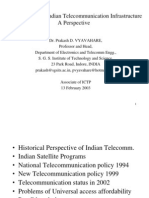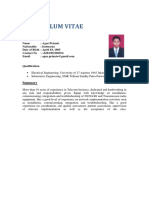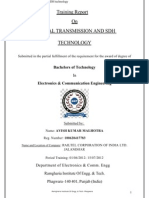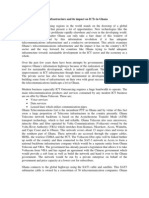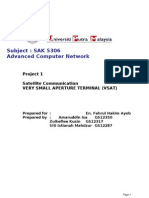Ha Earth Station
Ha Earth Station
Uploaded by
Raj TimalsinaCopyright:
Available Formats
Ha Earth Station
Ha Earth Station
Uploaded by
Raj TimalsinaOriginal Title
Copyright
Available Formats
Share this document
Did you find this document useful?
Is this content inappropriate?
Copyright:
Available Formats
Ha Earth Station
Ha Earth Station
Uploaded by
Raj TimalsinaCopyright:
Available Formats
rf}yf] jflif{sf]T;j :dfl/sf @)^$
4th Anniversary Souvenir 2008
Sagarmatha Satellite Earth Station-A Journey of 25 Years
Babu Kaji Shakya, M.Sc. (Engg.) Manager International Services Department Lok R Paneru B.E., M.Tech. (Satcom) for Station Manager Sagarmatha Satellite Station, Balambu Providing nationwide telecommunications service is a big challenge in Nepal due to its difficult terrain and wide geographical diversity. Very thin and distributed inhabitation and presence of high hills between one village and another in many places in the hilly region has added even more complexity. Hence use of any one of the means such as Microwave, Optical Fiber or Satellite alone is not sufficient to achieve the goal. However, role of Satellite Communication technology will remain dominant in Nepal, both in domestic as well as international applications due to difficult terrain and landlocked nature of this country. Nepal Telecom (then Nepal Telecommunication Corporation) established Sagarmatha Satellite Earth Station in 1982, as a section of International System Managers Office (now International Services Department), starting its service with only six SCPC channels for international communication. Later in 1985, TV receive facilities were added for providing news feed to Nepal Television. Using this video reception facility, World Cup football to was broadcasted by Nepal Television for the first time. Since then this station is in operation and has already completed its 25 years of successful operation. This station was originally established for international applications alone. This was because the satellite communication technology was not feasible for domestic applications then due to requirement of large antenna size and expensive recurring space segment charges. Thanks to fast development in this technology, now communication via satellite has become possible with smaller earth station antennas and accordingly space segment charges have also become viable. Hence this technology has become an attractive means for providing quality communication service to most remote and
difficult locations. Noting these facts, Sagarmatha station was opened for domestic applications in 1996 for first time. As of today this station is operating more than 3000 direct circuits for International telephony and data services, and is also equipped with equipments for video news service. Accordingly it is also providing VSAT services to more than 300 remote locations of the country and is also providing satellite links to major cities for national trunking service.
Some of the milestones of this station are: Oct 1982 Standard B Earth Station (STH-01B) Operational via INTELSAT 60E Satellite. Services started with 6 SCPC Circuits. 1985 TV Reception Service for Nepal TV 1987- Upgradation of Earth Station facilities with installation of: v IDR System v TV Equipment for Occasional Use TV
&#
rf}yf] jflif{sf]T;j :dfl/sf @)^$
Transmission/ Reception v Digital Microwave Link between Earth Station and International Telecom Building (ITB) v Uninterruptible Power Supply (UPS) System 1989- Nepal Became 116th Member of INTELSAT 1994 Addition of IDR Equipment, Introduction of Digital Access Cross Connect System (DACCS) and Low Rate Encoders (LRE) 1996 Commissioning of Standard A Earth Station (STH-02A) 1996 Implementation of VSAT System (NEC VSAT system for 7 Locations) 1997 - Introduction of Digital Circuit Multiplication Equipment (DCME) 2000 Implementation of Regional Satellite Trunk (RSAT) System (STH-03B Antenna) 2001 Provisioning of TV Up-linking Services for Nepal TV 2001 - Digitalization of Occasional Use TV Transmission/Reception System 2002 - Implementation of new VSAT System 2004 Introduction of TCM/IDR Services 2008- Implementation of DSAT, augmentation of Frequency converter system and introduction of Turbo Code IDR modems (on-going) Sagarmatha earth station, which started with only six telephone channels in 1982 for international application alone, has gone through large expansion during last 25 years. Today, this station is equipped with latest satellite equipments so as to provide a good quality service to our valued customers for both domestic and International applications. The growth in domestic and international services via Sagarmatha Earth Station is as follows: a. International services The details, as indicated below, show the growth in international circuit via Sagarmatha Earth Station during last twenty five years:
4th Anniversary Souvenir 2008
b. Domestic Services i. RSAT System This system was conceived in order to provide satellite connectivity to major cities so that connection from these cities to capital city Kathmandu could still be maintained even in case of failure of main links such as microwave or optical fiber. The details of RSAT links are as follows: S.No. 1 2 3 4 Links Kathmandu-Biratnagar Kathmandu Bhairahawa Kathmandu Nepalgunj Kathmandu Dhangadhi ii. VSAT system Nepal telecom is using DAMA technology in its VSAT system so as to achieve economy in space segment charges. This system comprises of 2 channel and 8 channel terminals for direct distribution of telephone lines. Currently VSAT telephone service has been provided to more than 300 remote locations of the country. Accordingly this VSAT system also consists of equipments that could be used to provide E1 connectivity to remote exchanges. As of today, five remote exchanges with 150 line capacity have been provided connectivity via VSAT. Other than the services mentioned above, a new system named as DSAT is currently in implementation phase. This system is intended for providing satellite connectivity to various district headquarters and remote locations for extension of GSM and CDMA mobile services. This service will be in Ku-Band, first of its kind in Nepal Telecom in SatCom applications, and will be carried via Sinosat satellite.
Satellite carrier size 2 Mbps 2 Mbps 2 Mbps 2 Mbps
&$
You might also like
- Wastewater Treatment Technologies Design Consideration by MritunjayDocument259 pagesWastewater Treatment Technologies Design Consideration by MritunjayThetti TunNo ratings yet
- Concise Guide to OTN optical transport networksFrom EverandConcise Guide to OTN optical transport networksRating: 4 out of 5 stars4/5 (2)
- COMP 20143 BSIT OBE FORMAT Human Computer Interaction PDFDocument5 pagesCOMP 20143 BSIT OBE FORMAT Human Computer Interaction PDFLuisa Francisco50% (2)
- Essential 4G Guide: Learn 4G Wireless In One DayFrom EverandEssential 4G Guide: Learn 4G Wireless In One DayRating: 4.5 out of 5 stars4.5/5 (12)
- ConclusionDocument2 pagesConclusionEmimal Alex100% (1)
- Latest Ku ReportDocument11 pagesLatest Ku Reportsujeet.jha.311No ratings yet
- Developments in Indian Telecommunication Infrastructure A PerspectiveDocument44 pagesDevelopments in Indian Telecommunication Infrastructure A PerspectiveImran AhmadNo ratings yet
- Antenna Vsat Maintenance ProposalDocument11 pagesAntenna Vsat Maintenance ProposalRachmat HidayatNo ratings yet
- 2 CV Agus Prianto - UpdatedDocument5 pages2 CV Agus Prianto - UpdatedkrismadwibrataNo ratings yet
- Varaprasad MNV Resume - 2019Document6 pagesVaraprasad MNV Resume - 2019Varaprasad ManikalaNo ratings yet
- IPSTAR Broadband Satellite: DR - Nongluck Phinainitisart President of Thaicom PLC 7 October 2009Document32 pagesIPSTAR Broadband Satellite: DR - Nongluck Phinainitisart President of Thaicom PLC 7 October 2009Azula TronNo ratings yet
- Performance Evaluation of DVB-T2 PDFDocument12 pagesPerformance Evaluation of DVB-T2 PDFmontri831No ratings yet
- Country Report On "Wireless Telecommunication in Nepal": Sinamangal, KathmanduDocument13 pagesCountry Report On "Wireless Telecommunication in Nepal": Sinamangal, Kathmandukks_82No ratings yet
- CV - Suryo - 2020 - BDG - 3Document6 pagesCV - Suryo - 2020 - BDG - 3Aries'Ta TroyNo ratings yet
- Mr. Lounes CharefDocument5 pagesMr. Lounes CharefLounes CharefNo ratings yet
- Satellite ServicesDocument43 pagesSatellite Servicesyoungdiana023No ratings yet
- BraodbandDocument11 pagesBraodbandTalha Abdul KhaliqNo ratings yet
- MAR2020 - APSCC e NewsletterDocument19 pagesMAR2020 - APSCC e NewsletterLuella LukenNo ratings yet
- Icon+ For Mobile Backhaul v1Document12 pagesIcon+ For Mobile Backhaul v1R. Mega MahmudiaNo ratings yet
- IntroDocument14 pagesIntroNisal Nuwan SenarathnaNo ratings yet
- Evans1996 PDFDocument8 pagesEvans1996 PDFBebe WellykiliNo ratings yet
- NT PC ReportDocument17 pagesNT PC ReportSandeep ShrivastavaNo ratings yet
- My Curiculum Vitae NewDocument6 pagesMy Curiculum Vitae NewShalihin AmtaNo ratings yet
- Satellite CommunicationDocument11 pagesSatellite CommunicationSyed FouzanNo ratings yet
- Sea Me WeDocument3 pagesSea Me WeM Zeeshan AnjumNo ratings yet
- UMTS-WCDMA Technology Overview NewDocument209 pagesUMTS-WCDMA Technology Overview NewRajneesh ThakurNo ratings yet
- Pranay NewDocument22 pagesPranay NewT. Mahipal ReddyNo ratings yet
- Training ReportDocument23 pagesTraining ReportAvissh MalhotraNo ratings yet
- Vsat Idr Dcme DSPTDocument57 pagesVsat Idr Dcme DSPTAMIT KUMARNo ratings yet
- Papers 1 RangkumDocument9 pagesPapers 1 RangkumRifki AmiruddinNo ratings yet
- Abdullah Kamal Foundation University Bs Telecom Abdullahkamal65@yahoo - Co MDocument10 pagesAbdullah Kamal Foundation University Bs Telecom Abdullahkamal65@yahoo - Co MFaizan AshrafNo ratings yet
- Education:: Uhammad OhailDocument2 pagesEducation:: Uhammad OhailRohail AdilNo ratings yet
- Priyanka Mahapatra 04231: Submitted By: Roll NoDocument15 pagesPriyanka Mahapatra 04231: Submitted By: Roll Noapi-3708553No ratings yet
- Andode Tuma PresentationDocument40 pagesAndode Tuma PresentationSintayehu TerefeNo ratings yet
- Arif Full GSM NetworkDocument220 pagesArif Full GSM NetworkArif PashaNo ratings yet
- Anupam SinghDocument3 pagesAnupam SinghFarzand AliNo ratings yet
- Atul ResumeDocument5 pagesAtul ResumeAtul SharmaNo ratings yet
- नेपाल टेलीकम SwotDocument8 pagesनेपाल टेलीकम SwotVivas PyasiNo ratings yet
- 17BEC0479 V.B.SrivathsavaDocument7 pages17BEC0479 V.B.Srivathsavababloo veluvoluNo ratings yet
- Sagarmatha Satellite Earth Station, Balamboo, Kathmandu, NepalDocument7 pagesSagarmatha Satellite Earth Station, Balamboo, Kathmandu, NepalGeshan Manandhar100% (1)
- Wachemo University DEPARTEMENT OF Electrical and Computer Engineering School of Post GraduatesDocument26 pagesWachemo University DEPARTEMENT OF Electrical and Computer Engineering School of Post GraduatesMitikuNo ratings yet
- Nepal Telecom Intern of AtulLekhnathMukesh Prabin2017Document51 pagesNepal Telecom Intern of AtulLekhnathMukesh Prabin2017Bhawesh kafle60% (5)
- BY Harshitha.S (1VI07TE022) Priyanka.N (1VI07TE038) Varun.K.P (1VI05TE058)Document47 pagesBY Harshitha.S (1VI07TE022) Priyanka.N (1VI07TE038) Varun.K.P (1VI05TE058)Kavya NarayanNo ratings yet
- PEMRA - Regulating The Carriage and Placement FeeDocument16 pagesPEMRA - Regulating The Carriage and Placement FeeHammadSaleem100% (1)
- Mr. Magdy M. Khalil: International Telecommunication UnionDocument33 pagesMr. Magdy M. Khalil: International Telecommunication UnionAbhishek SharmaNo ratings yet
- Vission: A Reliable Secured High User Friendly BandwidthDocument1 pageVission: A Reliable Secured High User Friendly BandwidthShaji ANo ratings yet
- Objective:: Ahmed Mustafa El-DerbyDocument4 pagesObjective:: Ahmed Mustafa El-DerbyAhmed El DerbyNo ratings yet
- Presentation From The Union of MyanmarDocument19 pagesPresentation From The Union of MyanmarPyae Phyo WaiNo ratings yet
- Telecommunications Infrastructure and Its Impact On Icts in GhanaDocument4 pagesTelecommunications Infrastructure and Its Impact On Icts in GhanaAustine EmegheboNo ratings yet
- 3G 05 Oveview of WCDMADocument14 pages3G 05 Oveview of WCDMAAssem Abdelraheem AsaadNo ratings yet
- FinalDocument15 pagesFinalAmogh G Rawoor -No ratings yet
- fINAL Project With SynopsisDocument78 pagesfINAL Project With SynopsisShama SharmaNo ratings yet
- Module 6Document22 pagesModule 6Stuti Sharma 21BEC1626No ratings yet
- Physical Layer Technologies and Challenges in Mobile Satellite Communications.Document5 pagesPhysical Layer Technologies and Challenges in Mobile Satellite Communications.IDESNo ratings yet
- NOCC PresentationDocument38 pagesNOCC PresentationAmit JaiswalNo ratings yet
- MTN GhanaDocument17 pagesMTN GhanaDaniel KoffiNo ratings yet
- chapter 4 mergedDocument66 pageschapter 4 mergedlaxmibamhane417No ratings yet
- VsatDocument31 pagesVsatapichanNo ratings yet
- Cost & Duration of TrainingDocument2 pagesCost & Duration of Trainingchuzlink2003No ratings yet
- Fundamentals of Network Planning and Optimisation 2G/3G/4G: Evolution to 5GFrom EverandFundamentals of Network Planning and Optimisation 2G/3G/4G: Evolution to 5GNo ratings yet
- Good Practice 12 Patient HandoverDocument4 pagesGood Practice 12 Patient HandoverDewi Ratna SariNo ratings yet
- Alternative ReadingsDocument9 pagesAlternative ReadingsElvin JuniorNo ratings yet
- Narration Class 12Document7 pagesNarration Class 12nallasingh78100% (3)
- AgDocument9 pagesAgnureen92No ratings yet
- Corgi Red Pembroke Cute Pets DIY Papercraft Toy Kawaii LuxDocument4 pagesCorgi Red Pembroke Cute Pets DIY Papercraft Toy Kawaii LuxThe Dragon Of Ice and FireNo ratings yet
- Ironmongeries - BOQ HOLD DOOR Format - Final-Revesion3Document9 pagesIronmongeries - BOQ HOLD DOOR Format - Final-Revesion3Hazem ElkholyNo ratings yet
- Full Download Pediatric Primary Care 6th Edition Catherine E. Burns (Editor) PDFDocument64 pagesFull Download Pediatric Primary Care 6th Edition Catherine E. Burns (Editor) PDFscreenciocoi100% (5)
- Technical Specification - Narada Edge 233L All-In-One Cabinet V1.0Document15 pagesTechnical Specification - Narada Edge 233L All-In-One Cabinet V1.0expressdemenageurNo ratings yet
- Harrison's Manual of Medicine 19th Edition Kasper & Al Download PDFDocument52 pagesHarrison's Manual of Medicine 19th Edition Kasper & Al Download PDFejubovhydrv100% (3)
- Lab Mannual DcomDocument32 pagesLab Mannual DcomRam KapurNo ratings yet
- Advanced-Ms-Excel-For-Data-Analysis NoteDocument73 pagesAdvanced-Ms-Excel-For-Data-Analysis NoteRadeeshaNo ratings yet
- Jane Eyre RealismDocument2 pagesJane Eyre RealismMheiywaAT100% (1)
- Informe EstadoDocument9 pagesInforme Estadoelber253No ratings yet
- HWI StressManagement and Self-CareDocument14 pagesHWI StressManagement and Self-CaresarvitaNo ratings yet
- January 2016 (IAL) QP - S1 EdexcelDocument13 pagesJanuary 2016 (IAL) QP - S1 EdexcelahamedNo ratings yet
- Design of An Employee Tracking System Using RFIDDocument7 pagesDesign of An Employee Tracking System Using RFIDInternational Journal of Innovative Science and Research TechnologyNo ratings yet
- 1566296779769AURUS MEMOIRS - CHRIST Book of MemoriesDocument100 pages1566296779769AURUS MEMOIRS - CHRIST Book of MemoriesravitNo ratings yet
- Full download Management Accounting Text Problems and Cases 6th Edition 125902668X pdf docxDocument24 pagesFull download Management Accounting Text Problems and Cases 6th Edition 125902668X pdf docxfasirchompi100% (2)
- Interview QSDocument3 pagesInterview QSrenNo ratings yet
- Volume 2 Part 5 - Estidama RequirementsDocument114 pagesVolume 2 Part 5 - Estidama Requirementsmohd.tbaishatNo ratings yet
- Atrl Profile-1Document46 pagesAtrl Profile-1sgewindiaNo ratings yet
- A Time History Analysis Method-4689Document8 pagesA Time History Analysis Method-4689Shekh Muhsen Uddin AhmedNo ratings yet
- DLC - Unit 1Document58 pagesDLC - Unit 1Bala SubramanianNo ratings yet
- Ind Nifty PharmaDocument2 pagesInd Nifty PharmaJackNo ratings yet
- HP EliteBook 6440b 6540b COMPAL LA-4891P KELL00 DIOR Discrete REV 0.1 SchematicsDocument50 pagesHP EliteBook 6440b 6540b COMPAL LA-4891P KELL00 DIOR Discrete REV 0.1 SchematicsSaid FakirNo ratings yet
- Yoga (Level A) CH 2 FinalDocument12 pagesYoga (Level A) CH 2 Finaljkc_iitmNo ratings yet
- Magika No Kenshi To Shoukan Maou - Volume 12Document362 pagesMagika No Kenshi To Shoukan Maou - Volume 12Michele RogersNo ratings yet







